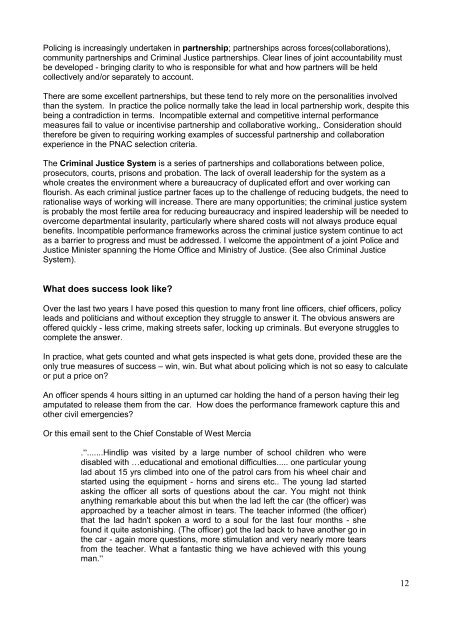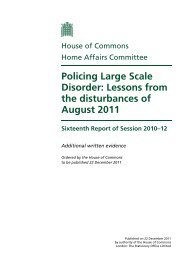Reducing Bureaucracy in Policing - Home Office
Reducing Bureaucracy in Policing - Home Office
Reducing Bureaucracy in Policing - Home Office
You also want an ePaper? Increase the reach of your titles
YUMPU automatically turns print PDFs into web optimized ePapers that Google loves.
Polic<strong>in</strong>g is <strong>in</strong>creas<strong>in</strong>gly undertaken <strong>in</strong> partnership; partnerships across forces(collaborations),<br />
community partnerships and Crim<strong>in</strong>al Justice partnerships. Clear l<strong>in</strong>es of jo<strong>in</strong>t accountability must<br />
be developed - br<strong>in</strong>g<strong>in</strong>g clarity to who is responsible for what and how partners will be held<br />
collectively and/or separately to account.<br />
There are some excellent partnerships, but these tend to rely more on the personalities <strong>in</strong>volved<br />
than the system. In practice the police normally take the lead <strong>in</strong> local partnership work, despite this<br />
be<strong>in</strong>g a contradiction <strong>in</strong> terms. Incompatible external and competitive <strong>in</strong>ternal performance<br />
measures fail to value or <strong>in</strong>centivise partnership and collaborative work<strong>in</strong>g,. Consideration should<br />
therefore be given to requir<strong>in</strong>g work<strong>in</strong>g examples of successful partnership and collaboration<br />
experience <strong>in</strong> the PNAC selection criteria.<br />
The Crim<strong>in</strong>al Justice System is a series of partnerships and collaborations between police,<br />
prosecutors, courts, prisons and probation. The lack of overall leadership for the system as a<br />
whole creates the environment where a bureaucracy of duplicated effort and over work<strong>in</strong>g can<br />
flourish. As each crim<strong>in</strong>al justice partner faces up to the challenge of reduc<strong>in</strong>g budgets, the need to<br />
rationalise ways of work<strong>in</strong>g will <strong>in</strong>crease. There are many opportunities; the crim<strong>in</strong>al justice system<br />
is probably the most fertile area for reduc<strong>in</strong>g bureaucracy and <strong>in</strong>spired leadership will be needed to<br />
overcome departmental <strong>in</strong>sularity, particularly where shared costs will not always produce equal<br />
benefits. Incompatible performance frameworks across the crim<strong>in</strong>al justice system cont<strong>in</strong>ue to act<br />
as a barrier to progress and must be addressed. I welcome the appo<strong>in</strong>tment of a jo<strong>in</strong>t Police and<br />
Justice M<strong>in</strong>ister spann<strong>in</strong>g the <strong>Home</strong> <strong>Office</strong> and M<strong>in</strong>istry of Justice. (See also Crim<strong>in</strong>al Justice<br />
System).<br />
What does success look like?<br />
Over the last two years I have posed this question to many front l<strong>in</strong>e officers, chief officers, policy<br />
leads and politicians and without exception they struggle to answer it. The obvious answers are<br />
offered quickly - less crime, mak<strong>in</strong>g streets safer, lock<strong>in</strong>g up crim<strong>in</strong>als. But everyone struggles to<br />
complete the answer.<br />
In practice, what gets counted and what gets <strong>in</strong>spected is what gets done, provided these are the<br />
only true measures of success – w<strong>in</strong>, w<strong>in</strong>. But what about polic<strong>in</strong>g which is not so easy to calculate<br />
or put a price on?<br />
An officer spends 4 hours sitt<strong>in</strong>g <strong>in</strong> an upturned car hold<strong>in</strong>g the hand of a person hav<strong>in</strong>g their leg<br />
amputated to release them from the car. How does the performance framework capture this and<br />
other civil emergencies?<br />
Or this email sent to the Chief Constable of West Mercia<br />
.”.......H<strong>in</strong>dlip was visited by a large number of school children who were<br />
disabled with …educational and emotional difficulties..... one particular young<br />
lad about 15 yrs climbed <strong>in</strong>to one of the patrol cars from his wheel chair and<br />
started us<strong>in</strong>g the equipment - horns and sirens etc.. The young lad started<br />
ask<strong>in</strong>g the officer all sorts of questions about the car. You might not th<strong>in</strong>k<br />
anyth<strong>in</strong>g remarkable about this but when the lad left the car (the officer) was<br />
approached by a teacher almost <strong>in</strong> tears. The teacher <strong>in</strong>formed (the officer)<br />
that the lad hadn't spoken a word to a soul for the last four months - she<br />
found it quite astonish<strong>in</strong>g. (The officer) got the lad back to have another go <strong>in</strong><br />
the car - aga<strong>in</strong> more questions, more stimulation and very nearly more tears<br />
from the teacher. What a fantastic th<strong>in</strong>g we have achieved with this young<br />
man.”<br />
12

















